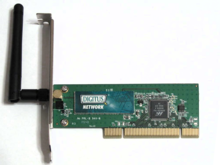A wireless LAN (WLAN) is a wireless computer network that links two or more devices using wireless communication to form a local area network (LAN) within a limited area such as a home, school, computer laboratory, campus, or office building. This gives users the ability to move around within the area and remain connected to the network. Through a gateway, a WLAN can also provide a connection to the wider Internet.
Most modern WLANs are based on IEEE 802.11 standards and are marketed under the Wi-Fi brand name.
Wireless LANs have become popular for use in the home, due to their ease of installation and use. They are also popular in commercial properties that offer wireless access to their employees and customers.
Norman Abramson, a professor at the University of Hawaii, developed the world's first wireless computer communication network, ALOHAnet. The system became operational in 1971 and included seven computers deployed over four islands to communicate with the central computer on the Oahu island without using phone lines.[1]
Wireless LAN hardware initially cost so much that it was only used as an alternative to cabled LAN in places where cabling was difficult or impossible. Early development included industry-specific solutions and proprietary protocols, but at the end of the 1990s these were replaced by standards, primarily the various versions of IEEE 802.11 (in products using the Wi-Fi brand name). Beginning in 1991, a European alternative known as HiperLAN/1 was pursued by the European Telecommunications Standards Institute (ETSI) with a first version approved in 1996. This was followed by a HiperLAN/2 functional specification with ATM influences[citation needed] accomplished February 2000. Neither European standard achieved the commercial success of 802.11, although much of the work on HiperLAN/2 has survived in the physical specification (PHY) for IEEE 802.11a, which is nearly identical to the PHY of HiperLAN/2.
In 2009 802.11n was added to 802.11. It operates in both the 2.4 GHz and 5 GHz bands at a maximum data transfer rate of 600 Mbit/s. Most newer routers are able to utilise both wireless bands, known as dualband. This allows data communications to avoid the crowded 2.4 GHz band, which is also shared with Bluetooth devices and microwave ovens. The 5 GHz band is also wider than the 2.4 GHz band, with more channels, which permits a greater number of devices to share the space. Not all channels are available in all regions.

Networking can be confusing to know the kind of people who can help you in all phases of your personal and professional life. If you need a new job, you have a network of people, web design dubai company who can get you information on organizations that might be carrying. If you are looking for a date to dance, you have a network of friends who can tell you who has or hasn't been asked yet. If you are going to run a marathon for the first time, there's bound to be somebody in your network of associates who is a runner and knows about what shoes you need to buy. Computers improve networking because you can easily email everyone you know with one click of the mouse, so to speak.
ReplyDelete